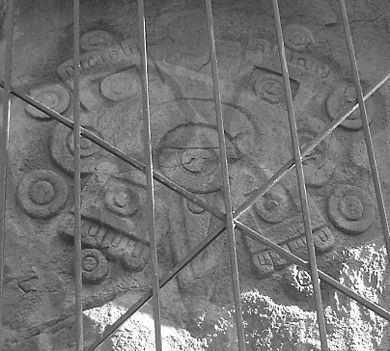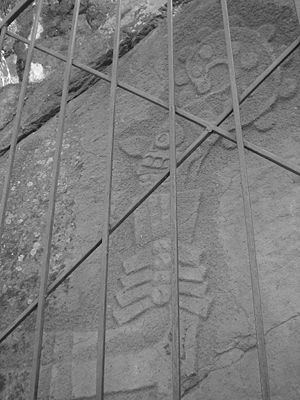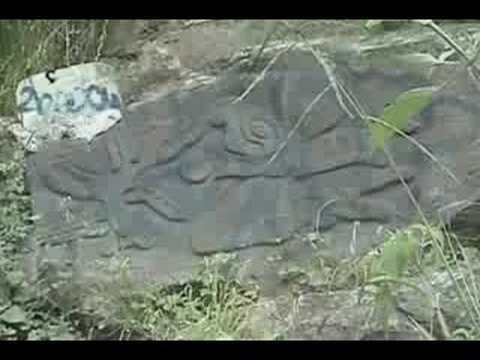Culture Xochimilcas | INAH Official Page Non existent | |
 | ||
Name Chuahilama Hill Ceremonial Center Period Late mesoamerican Preclassical - 1200–1500 CE. | ||
Cerro cuahilama punta del iceberg de un espacio arqueol gico mayor en xochimilco
Cuahilama is a Hill and an archaeological site located south east of Santa Cruz Acalpixca, in the Cuahilama neighborhood, near the Xochimilco Archaeological Museum. It was a ceremonial center, in the hill are prehispanic images engraved in basaltic rock.
Contents
- Cerro cuahilama punta del iceberg de un espacio arqueol gico mayor en xochimilco
- Cuahilama
- Location
- History
- Archaeological Zone
- Descripcin
- Current status
- Site Importance
- References

Cuahilama
Location

The “Cuahilama Cerro” or Cuailama, is located at “prolongación 2 de abril” Street, between streets Cacalanco and 3 de mayo, very near the Santa Cruz Acalpixca town. In the Xochimilco borough, south east of México City
History

The Xochimilco area was inhabited by Preclassical groups Cuicuilco, Copilco and Tlatilco (1500-200 BCE), and subsequently, in the period Classical period, by the Teotihuacano (CA. 200 BCE-700 CE).

Apparently, Acalpixca was founded by the xochimilcas around 1254 CE, the first nahuatlacas tribes arrived from Aztlán in the north to the Anáhuac Valley in 1265 CE, the first Xochimilca Lord, Acatonalli, founded the village on the Hill Cuauhilama. Between 1450 and 1521, Santa Cruz Acalpixca was a small village, although capital of the area, it was during this period that the petroglyphs were made.
Those settlers were farmers, founded the settlement with Acatonalli, its first ruler, who while facing food shortages proposed before the Council of elders, placing wooden rods filled with organic dirt, thereby over the water, creating the Chinampa in the Lake, agricultural method that has been transmitted from generation to generation since prehispanic times until the present day, they produced corn, chile, beans, pumpkin and flowers as well as other crops.
From Cuahilama, the Xochimilcas would have extended over the southern shore of the Xochimilco lake, the islets of Tláhuac and Míxquic, and towards the Ajusco-Chichinauhtzin mountain range.
Archaeological Zone
At Cuahilama (Nahuatl= “old woman head”) is an observatory, a shrine and a prehispanic causeway that runs east- west and provided access to the top of the hill, where the ceremonial area was probably located, and to agricultural terraces; the basements of residential quarters are registered over an area of 400 m² and a Xochimilca “jolla or military training camp.
The site depicts cultural Aztec characteristics and possibly was a ceremonial center linked with agricultural fertility festivities and worship of the Sun reflected on calendar and astronomical events.
This prehispanic settlement celebrated every 52 years, the “Fuego Nuevo” (New Fire) ceremony, to ensure the arrival of the new sun.
The site is famous for the petroglyphs located on the hillside and the slopes of the Hill, are prehispoanic Petroglyphs dating back to between 1200 and 1500 CE, these expressed the Xochimilcas views, and have been attributed ceremonial functions and deity veneration.
The Petroglyphs are stars, constellations and figures representations reportedly associated with the cult of fertility.
Descripción
Current status
A sad situation affects the archaeological zone of Cuahilama, predators, vandalism and undeniably apathy of authorities and society itself.
Little has been done against the deterioration of the archaeological remains, which is on the verge of losing every cultural value as a result of urban growth and lack of protection by municipal authorities and the Instituto Nacional de Antropología e Historia (INAH), in spite of public complaints of looting of archaeological pieces, nothing has been done in the area. The Petroglyphs are unprotected, damaged by graffiti and abandonment.
The zone is private property, but the owners lack title to land, only private contracts, so purchase of the land is not possible.
Site Importance
Cuahilma is not a relevant site: INAH
When INAH was questioned on the lack of maintenance, they responded that in Mexico there are more than 10 thousand archaeological sites, and some "are of great relevance". The petroglyphs found in this area of Xochimilco are Aztec and were venerated deities; are stars representations, constellations and figures apparently associated with fertility cult.
